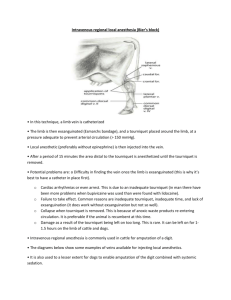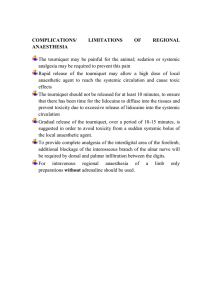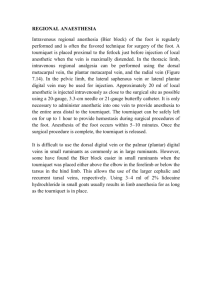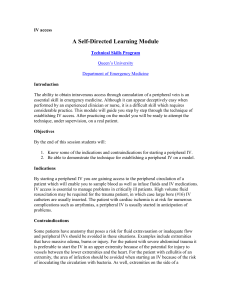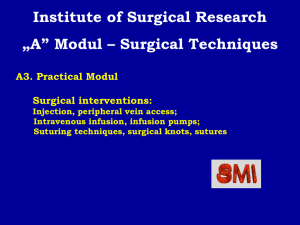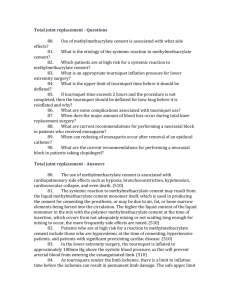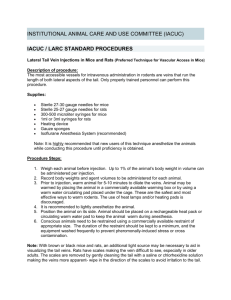Intravenous Regional Anesthesia
advertisement
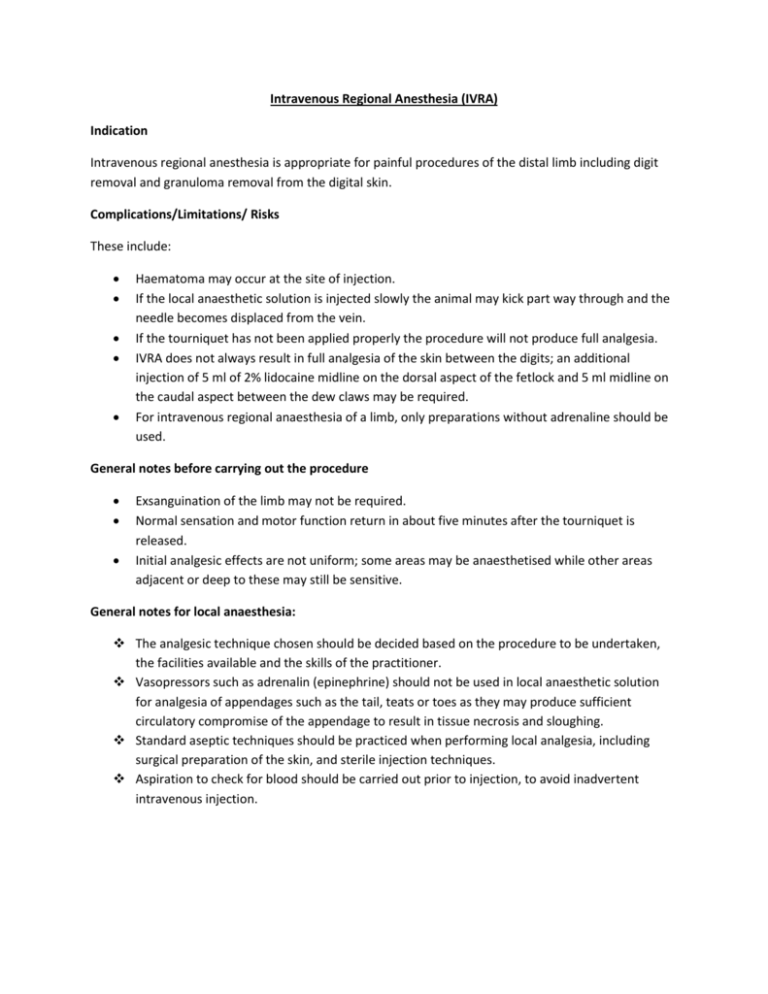
Intravenous Regional Anesthesia (IVRA) Indication Intravenous regional anesthesia is appropriate for painful procedures of the distal limb including digit removal and granuloma removal from the digital skin. Complications/Limitations/ Risks These include: Haematoma may occur at the site of injection. If the local anaesthetic solution is injected slowly the animal may kick part way through and the needle becomes displaced from the vein. If the tourniquet has not been applied properly the procedure will not produce full analgesia. IVRA does not always result in full analgesia of the skin between the digits; an additional injection of 5 ml of 2% lidocaine midline on the dorsal aspect of the fetlock and 5 ml midline on the caudal aspect between the dew claws may be required. For intravenous regional anaesthesia of a limb, only preparations without adrenaline should be used. General notes before carrying out the procedure Exsanguination of the limb may not be required. Normal sensation and motor function return in about five minutes after the tourniquet is released. Initial analgesic effects are not uniform; some areas may be anaesthetised while other areas adjacent or deep to these may still be sensitive. General notes for local anaesthesia: The analgesic technique chosen should be decided based on the procedure to be undertaken, the facilities available and the skills of the practitioner. Vasopressors such as adrenalin (epinephrine) should not be used in local anaesthetic solution for analgesia of appendages such as the tail, teats or toes as they may produce sufficient circulatory compromise of the appendage to result in tissue necrosis and sloughing. Standard aseptic techniques should be practiced when performing local analgesia, including surgical preparation of the skin, and sterile injection techniques. Aspiration to check for blood should be carried out prior to injection, to avoid inadvertent intravenous injection. Procedure: the animal was sedated using xylazine and restrained Clip and disinfect over a convenient prominent superficial limb vein distal to where the tourniquet will be placed. The lateral digital vein immediately proximal to the fetlock may be used. The radial vein or median palmar digital vein may be used on the forelimb, the lateral branch of the lateral saphenous vein, or the lateral plantar vein, or the lateral plantar digital vein may be used on the hind limb. In this lab the dorsal common digital flexor vein III was used in the forelimb and the tourniquet was placed below the hock. Additionally the torniquet may be placed in the proximal metatarsal or proximal metacarpal region or above the hock or carpus The tourniquet must be applied tightly. A needle was inserted into the vein, directed distally. Aspirate blood to confirm that the needle is properly positioned within a vein. Inject an appropriate amount of local anaesthetic solution, e.g.in this lab 14 ml of 2% lidocaine was injected. Withdraw the needle and massage the injection site for a few seconds to prevent haematoma formation. Anaesthesia should be complete in five minutes and persist for 1-2 hours if the tourniquet is left in place Analgesia should be in effect after ten minutes Check after ten minutes whether full analgesia has been achieved: it is important to check the state of analgesia in the deep tissues prior to beginning a surgical procedure involving these tissues General information o o o o o o It is particularly important to confirm that the caudal aspects of the interdigital cleft are insensitive as this is often the last area to become fully anaesthetized Sometimes the skin between the digits is not fully anaesthetised; in such cases inject 5 ml of 2% lidocaine midline on the dorsal aspect of the fetlock and 5 ml midline on the caudal aspect between the dew claws. Analgesia remains until the tourniquet is removed. Following surgery (up to 45 minutes) release the tourniquet slowly over about ten seconds. Release should not cause any problems if at least ten minutes have elapsed between injection and release of the tourniquet. The tourniquet may be left in place for up to1.5 hours without ill effect
